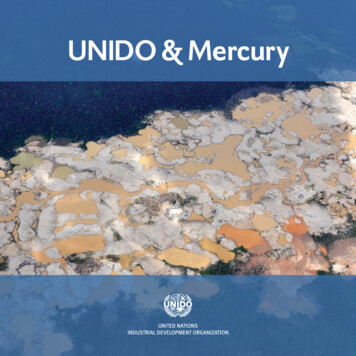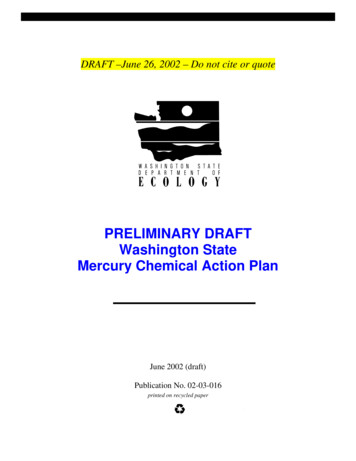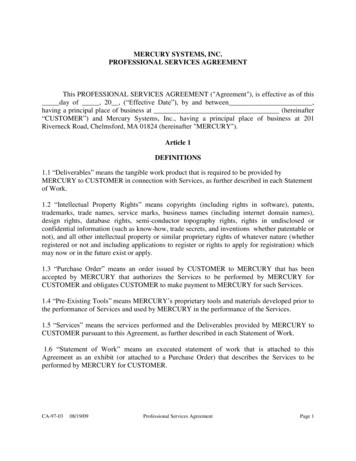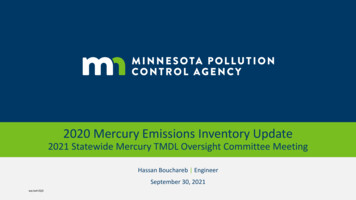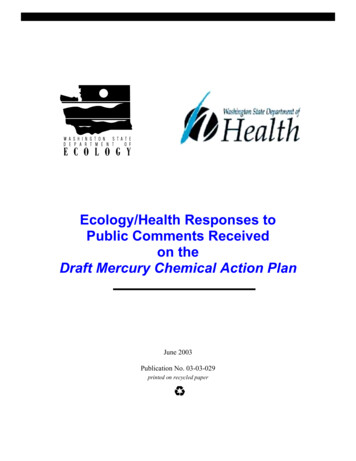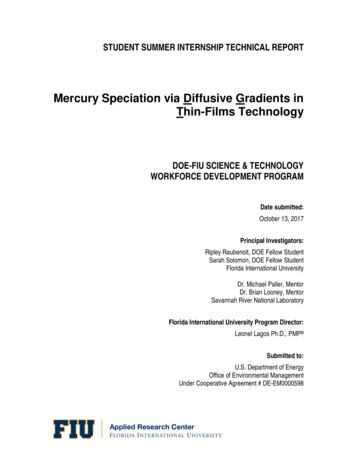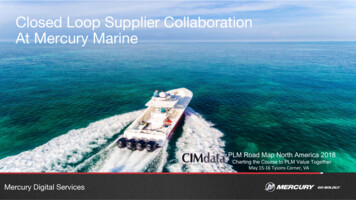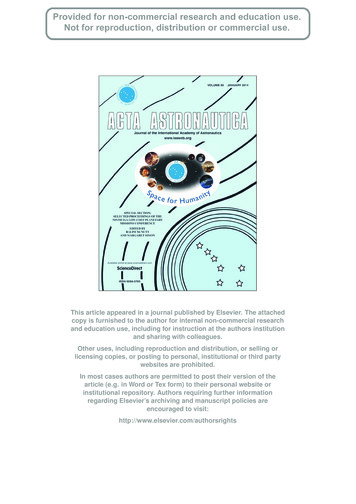
Transcription
EliminatingMercury in HospitalsEnvironmental Best Practices for Health Care Facilities November 2002JCAHO Environment of CareStandards 1.3, 2.3, 4.0How Pervasive and Harmfulis Mercury in the Environment?Mercury is a toxic pollutant and is listed as one of 12 priority chemicals bythe EPA Persistent, Bioaccumulative, and Toxic (PBT) Chemical Program.Consuming fish from mercury-polluted water bodies can severely affect thecentral nervous system; impair hearing, speech and gait; and cause blindness,tremors, insomnia, emotional instability, paralysis, loss of muscular control,and even death.1 Fish consumption advisories for mercury have been issued forthousands of water bodies nationwide, including all the Great Lakes and theirconnecting waters, more than 79,000 other lakes and more than 485,000 milesof rivers. In 2001, 49 states had issued mercury advisories for lakes, rivers, andother water bodies.2Neonatal exposure to mercury has been linked to several serious birth defectsand recent research suggests that prenatal effects occur at mercury intake levels5 to 10 times lower than that of adults. Additionally, a National Academies ofScience report from July 2000 showed that 60,000 children are born in the U.S.each year with neurological problems because of exposure to methylmercuryin utero.3Numerous cases of mercury poisoning, primarily through inhalation, have beendocumented in the workplace. In a survey conducted by the National Institutefor Occupational Safety and Health, researchers estimated that 70,000American workers might be exposed to mercury vapors on the job, includingnurses, lab technicians, and others working in health care facilities.4 In addition,families of these workers were identified to be at risk of exposure from mercurycontaminated work clothes brought home by workers.5Mercury Exposure Pathways In utero Consuming mercury-contaminated fish Inhaling mercury vapors in the workplace Handling work clothes contaminatedwith mercuryAtmospheric Mercury Contributionsby Industry Sector(1997, EPA)Medical WasteIncinerators13%Coal-FiredUtility Boilers40%IndustrialBoilers23%MunicipalWaste Combustors24%What Are The Industrial Sources Of Mercury?Although mercury is naturally occurring in volcanoes, natural deposits, and oceanic volatilization, human activities have substantially increased theamount of mercury cycling through the ecosystem. A 1997 EPA study6 identifying industrial processes that contributed heavily to atmospheric mer cury found that medical waste incinerators (MWI) contribute 13 % (the fourth-largest source) of the anthropogenic mercury emissions to the envi ronment. Additionally, hospitals contribute 4 to 5% of the total wastewater mercury load in some communities.7 Many local wastewater treatmentplants have identified hospitals as industrial pollution sources and have imposed strict wastewater limits for mercury (see Case Study 2).Eliminating or reducing mercury use not only lowers compliance costs, but also minimizes the potential for expensive spill cleanups.(For more information on mercury sources and health effects, see www.h2e-online.org/about/mercury.htm.)continues
page 2Environmental Best Practices for Health Care FacilitiesEliminating Mercury in HospitalsWhy Commit to Being Mercury-Free?Public Health—Hospitals most frequently commit to becoming mercury-free based on an ethical motivation to protect human health and the environment. This desireoften supports the hospitals’ mission statements which commonly include a goal of “assessing and improving community health.” As significantusers of products containing mercury, hospitals have an opportunity to play a key role in protecting public health by minimizing the use and releaseof mercury into the environment.Regulations —Mercury waste is regulated under the Resource Conservation Recovery Act (RCRA), which requires all hazardous waste handlers to have speciallytrained staff and equipment on hand in case of a spill or release. Additionally, these facilities must meet special storage, handling, disposal, wastetracking, and reporting requirements. Failure to meet any of these requirements can result in fines up to 25,000 per day.By August 2002,over 300 health care facilitiesnationwide had already takenthe "Hospitals for a HealthyEnvironment Pledge."For more information seewww.h2e-online.orgVoluntary Agreements —Because of health care’s contribution of mercury to the environment, EPA and the American HospitalAssociation (AHA) signed a memorandum of understanding in 1998 committing to the virtualelimination of mercury from hospitals by 2005.8The following sections of this fact sheet present information about mercury-containing devices andchemicals, alternatives to mercury-containing products, vendor information, and case studies of successfulmercury elimination programs. This fact sheet also contains links to other important resources for com pleting a mercury inventory, setting up a mercury elimination program, and taking the steps necessaryto eliminate mercury at your hospital.Two recent independent studies10, 11 have foundsignificant accuracy problems associated withmercury thermometers:1EPA Mercury White Paper. A Listing of Fish and Wildlife Advisories. May 2002. www.epa.gov/waterscience/fish/3National Academies of Science, National Research Council. July 2000. “Toxicological Effectsof Methylmercury.”4Anne Nadakavukaren. “Our Global Environment: A Health Perspective”. 1995.5Guy Williams. “Mercury Pollution Prevention in Healthcare.” National Wildlife Federation. July 1997.6EPA. EPA-452/R-97- 004. “Mercury Study Report to Congress, Volume II: An Inventory ofAnthropogenic Mercury Emissions in the United States”. December 1997.7“Making Medicine Mercury-Free: A Resource Guide for Mercury-Free Medicine.” Health Carewithout Harm. 2001.8Health Care Without Harm, in partnership with the U.S. Environmental Protection Agency, theAmerican Hospital Association and the American Nurses Association, has launched Hospitals fora Healthy Environment (H2E). www.h2e-online.orgMost mercury-containing equipment have a mercury-free alternative. Althoughsome mercury-free alternatives may initially cost more, facilities often find thattheir initial capital costs are outweighed by the total costs associated with mercurycleanup equipment, spill costs and liabilities, and handling and disposal costs andliabilities (see Table 1, page 5).25% of new mercury thermometers wereinaccurate by at least 0.2 degrees C 28% of mercury thermometers were inaccu rate by at least 0.1 degree C[The ASTM standard for glass/mercury medicalthermometers specifies a maximum allowableerror of 0.1 C in the cited range.]Mercury Thermometers:Prone To InaccuraciesWhere Is Mercury Found in Hospitals?Although mercury is found in many places within hospitals, a mercury elimination planshould include a prioritized list of targets. For example, the California Department ofHealth Services (CA DHS)9 conducted mercury inventories at six northern Californiahospitals in 1999 and found that sphygmomanometers and gastroenterology instru ments accounted for 89 percent of the mercury in these hospitals. Mercury Sphygs:Worthy of Gold Standard Status?A study12 of 444 mercury sphygs found: 55% showed zero level between10 and 20 mm Hg 38% had dirty columns thatobscured readings 20% of the columns were not vertical 5% had blocked air filters 3 units had visible mercurydroplets outside the mercury tubeMercury can be found in many commonly-used hospital devices and materials including:Thermometers Contain about 0.5 gram of mercury (laboratory thermometers contain 2 to 10 grams of mercury) Generally account for a small percentage of total mercury at hospitalscontinues
Eliminating Mercury in Hospitalspage 3Environmental Best Practices for Health Care Facilities An important source of mercury contamination of nonhazardous waste streams because they are often disposed of improperly In contact with staff and patients more than any othermedical device Mercury Sources in Seven Northern California Hospitals(California Department of Health Services, September, 2000)Broken thermometers inappropriately disposed of in redbags or sharps containers may be incinerated and releasemercury into the environmentEngineering1.43%A UCLA Medical Center study found that broken mercurythermometers were the most common sources of mercuryspills—accounting for over 55% of incidentsFluorescents0.067%Gastroenterology42.3% Alternatives are readily available (see thermometer inset thatThermometers0.66%Switches0.12%Sphygscontains detailed data on the efficacy, cost, and featuresof both mercury and mercury-free fever thermometers)46.5%X-ray tubes0.06%Nonclinical8.17%Sphygmomanometers (blood pressure monitors)Barostats0.04% Contain 70 to 90 grams of mercury Typically located in heavily used areas including patientrooms, waiting areas, triage centers, and offices where thepotential for patient or health care worker exposure tomercury is high The equipment at hospitals that often contain the largest amount of mercury Without regular maintenance, mercury sphygs can be inaccurate Alternatives are readily available (see sphyg insert that contains detailed data on the efficacy, cost, and features of both mercury andmercury-free sphygs)Fixatives andstains0.04%Cantor and Miller Abbot tubes (also called esophageal bougies and Sengstaken-Blakemore tubes)—Used to clear gastrointestinal [GI] restrictions The equipment at hospitals that often contain the second largest concentration of mercury A single set of bougie tubes can contain up to 454 grams of mercury FDA device failure database shows 58 incidents from 1991 to 2000 in which GI tubes broke and released mercury inside patients 13 Alternatives are readily available; some substitutes are weighted with air or water while others are preweighted with tungsten; because the mercuryin GI tubes functions as a weight, rather than a measurement device, the performance of alternatives is less questionable, and tungsten-weighteddevices are considered just as effective Additionally, tungsten-weighted alternatives have the advantage of being opaque in X-rays, allowing detection of the dilator as it movesthrough the bodyNon-Clinical Mercury Sources (sphyg repair kits, barometers, switches, etc.) Barometers contain about 800 grams of mercury and can be replaced with a 1-millibar precision aneroid for less than 250 or simply rely on alocal airport or weather station for data Eliminating mercury sphygs renders a repair kit containing mercury obsoleteOther SourcesStaining solutions and laboratory reagents(thimerosal, mercury chloride, immusal, and carbol-fuchin)Check the mercury content of your chemical atwww1.netcasters.com/mercury/ Tissue fixatives (Zenker’s solution and B5) Thermostats Batteries Manometers on medical equipment Esophageal dilators (also called Maloney or Hurst bougies) Fluorescent and high-intensity lamps Cleaning solutions continues
page 4Environmental Best Practices for Health Care FacilitiesEliminating Mercury in HospitalsTaking the Leap.How do you get a mercury reduction program rolling? Here’s a step-by-step plan for making mercury reduction a priority at your hospital(also see Case Study 1, page 6):Step 1 - Make A CommitmentUCLA Mercury Spill Frequency (1997-1999)(average of 18 mercury spills per year)Get support from the top. Talk to your hospital leadership, and get asigned statement to be mercury-free.Establish a mercury-free team. Designate a program leader who willbe enthusiastic and dedicated to the program and would identify aperson in each department who has the authority to make departmen tal changes in order to build support.Other15%Step 2 - Conduct A Mercury InventorySink traps13%Create a baseline inventory of mercury-containing products in yourhospital against which progress can be measured.Mercury inventory tools are widely available on the Internet. TheMercury Assessment Toolkit produced by the CA DHS is particularlycomprehensive, easy to adapt to hospital-specific conditions, easy touse, and tracks reductions automatically.See www.dhs.ca.gov/ps/ddwem/environmental/med waste/medwasteindex.htm for additional information.Thermometers55%Sphygs17%Step 3 - Evaluate AlternativesEvaluate mercury-free alternatives in the context of your hospital. Is the performance comparable? What is the purchase cost for alternatives? For accessories?For maintenance? Are these costs offset by lower handling, disposal, and liabilitycosts?Contact the vendors listed at the end of this fact sheet for more infor mation on mercury-free alternatives to common hospital devices, orcheck out these web sites: www.sustainablehospitals.org andabe.www.ecn.purdue.edu/ mercury/src/devicepage.htm Spill cleanup costs: Labor: approximately 10,000/yearDisposal: approximately 34/pound 42% of the hazardous material unit incidentsinvolved mercury Hazardous material unit spent 90 hours/yearresponding to mercury-related spills Hazardous material team cost 100 per hour resultingin a labor cost alone of 28,059 for the 3-year periodStep 4 - Establish Goals And Implementation PlansSet short-term, measurable goals that match your hospital’s resources. Reasonable goals, such as the elimination of mercury sphygmomanometerswithin 2 years, are easily measured and proposed as part of a hospital’s business plan. Once attained, the goals can provide a springboard for newmercury reduction projects.continuesMatching Mercury Replacement Strategies with BudgetsTargeted DeviceSphygmomanometersFinancially StrappedReplace at servicing intervalsCapital Budgets AllocatedReplace as many as possible with availablefunding, then phase out remaining deviceswhen brokenGastrointestinal TubesReplace when expiredReplace immediatelyThermometersReplace a set percentage each quarter or yearImplement a one-time mass replacementtargeting departments with high breakage first
Eliminating Mercury in Hospitalspage 5Environmental Best Practices for Health Care FacilitiesStep 5 - Institute Best Management PracticesEducate staff regarding the hazards of mercury and proper handling and disposal. Eliminate mercury-containing equipment and products. Establish and monitor mercury-free purchasing policies. Step 6 - Measure SuccessUse your mercury inventory (from Step 2) to re-evaluate your facility. Identify yoursuccesses and modify your plan as necessary. Most importantly, get the messageout to hospital staff members that they are making a difference!(Table 1)Mercury Spill Training and Equipment13TrainingCostTrainees 90(3 employees x 2 hrs x 15/hr) loss of productivityTrainer (2 hrs x 20/hr) 40 loss of productivityStep 7 - Keep The Mercury OutWork with your purchasing department to make sure that mercury products donot find their way back into the hospital. Require vendors to disclose the mercurycontent of products that you intend to purchase. See “Tools for Change” atwww.sustainablehospitals.org for an example of a vendor product mercury-contentdisclosure agreement and mercury-free purchasing policy language.EquipmentCostSpill Kit and 519Draeger Mercury SnifferTotal Cost: 649Mercury SpillsDepending on the type and size of the spill and the facility, mercury cleanups at hospitals are sometimes handled by staff if they are trained andavailable, or otherwise addressed by cleanup contractors. While mercury spill data from a wide variety of health care facilities including large andsmall, urban and rural, emergency, research and clinical facilities are generally unavailable or incomplete, the best available data comes from a largehospital at the University of California, Los Angeles (UCLA) between 1997 and 1999 (see summary on previous page).What Does It Cost To Prepare For and Clean Up Mercury Spills?Because of health and safety considerations and the environmental impact of mercury,any hospital that stores and uses mercury-containing devices within its facility is requiredby federal regulations to be prepared to handle mercury spills. Table 1 shows costs formercury spill training and equipment that a hospital will incur, and Table 2 lists liabilitycosts that a hospital might incur. Actual cleanup costs for several spill scenarios areitemized in the sphyg and thermometer inserts.(Table 2)Human Health and Environmental Liability}}Exposures,Workers’ Compensation,Lost Time,and LawsuitsCase-specificFines andLawsuits forImproper CleanupsAnd DisposalUp to 75,000 possible jail sentence9California Department of Health Services. 2000. A Guide to Mercury Assessment and Eliminationin HealthCare Facilities. www.dhs.ca.gov/medicalwaste10Leick-Rude, M.K. and Bloom, L.F. 1998. A Comparison of Temperature-Taking Methods in Neonates. Neonatal Network. Volume 17. Number 5. Pages 21-37.11Mayfield, S. R. et al. 1984. Temperature Measurements in Term and Preterm Neonates. Journal of Pediatrics. Volume 104. Number 2. Pages 271-275 as cited in Leick-Rude,M.K. and Bloom, L.F. 1998.12N.K. Markandu, F. Whitcher; A. Arnold and C. Carney. “The Mercury Sphygmomanometer Should Be abandoned Before it is Proscribed.” Journal of Human Hypertension.Volume 14, pages 31 through 36. 2000.13Holly J. Barron. HealthSystem Minnesota Mercury Reduction “MnTAP Intern Project Report.” 2000.continues
page 6Environmental Best Practices for Health Care FacilitiesEliminating Mercury in HospitalsThe following three case studies are summarized in terms of “Impetus,” “Actions,” and “Results” to help identify the challenges faced by hospitals andthe solutions they employed to start eliminating mercury. While each hospital is unique, these case studies may help you anticipate hurdles andestimate costs associated with mercury elimination.case studystudy 0101 Mercury Costs Prompt Elimination Program in Rochester, NYImpetus:The 750-bed Strong Memorial Hospital (SMH) is the primary teaching hospital of the University of RochesterMedical School and is a regional trauma center. Since 1997, SMH has implemented a focused mercuryreduction plan to eliminate the problems associated with spill response, disposal, and training.Actions:Executive involvement and support: SMH signed a memorandum of understanding with the Monroe County Health Department CEO assigned program personnel and resourcesStaff training and involvement: Trained staff in program objectives and mercury awareness Multidisciplinary teams identified mercury-containing devices and mercury use Developed a mercury training poster for newly hired nurses Developed and distributed a mercury use and disposal pamphlet Added a mercury-specific training unit to the annual Resource Conservation Recovery Act (RCRA) training,including a “show-and-tell” for different mercury-containing items encountered during routine maintenance Included questions on Joint Commission on Accreditation of Healthcare Organization (JCAHO) safetysurveys about proper mercury disposal and a check box noting the presence of mercury-filled sphygs Added a hazardous materials section (including mercury) to the project manager’s renovation andconstruction manualMercury Collection:Developed and implemented procedures to improve staff use of mercury collection facilities including:– Placing specially-labeled collection containers for mercury thermometers within patient care units– Adding labels on or near sharps containers to remind staff members not to place thermometersin the medical waste containersYearThermometers Sphygs– Establishing easy-to-access battery drop-off locationsPre-19979,444900– Establishing a centralized collection point for used7,7065001997fluorescent lamps 2001Results:524Replaced all mercury sphygs Reduced mercury thermometer use by over 90% – encountered difficulty replacing thermometers in theneonatal intensive care unit due to infection control concerns SMH’s program cited as an example of a quality improvement initiative during the 1998 JCAHO survey Eliminated annual disposal of 45 pounds of mercury-filled GI tubing by purchasing only tungsten-filledGI tubing since the program began Histopathology and other clinical laboratories discontinued use of mercury compounds 0
Eliminating Mercury in Hospitalscasecase studystudy 0202 Environmental Best Practices for Health Care Facilitiespage 7Wastewater Violations Force Change in Boston, MAImpetus:Beth Israel Deaconess Hospital began its mercury reduction program in 1993 when the local sewer districtlowered mercury limits in industrial wastewater to 1 part per billion (ppb) resulting in subsequent fines of 118,000 for exceedences. Beth Israel’s wastewater contained approximately 360 ppb mercury.Actions: Results:(Baseline Wastewater Mercury Content: 360 ppb mercury) Training, awareness and lab chemical replacement reduced mercury content to 100 ppb Trap and pipe cleaning reduced content to 4–8 ppb Improved wastewater treatment reduced content to 1 ppbcasecase studystudy 0302 Trained staff on mercury sources and proper disposal methods, posted wastewater data, and changed thecollection process for mercury-laden chemicals including the fixatives B5 and Zenker’s solution Infrastructure upgrades: cleaned traps and pipes End-of-pipe treatment: installed a sand filter ( 40,000) and a dewatering unit ( 60,000) both requiringminimal maintenance Instituted a wastewater sampling program to establish a baseline for measuring its progressSpills Prompt Mercury-Free Commitment in Grand Rapids, MIImpetus:Butterworth Hospital with 529 beds made a commitment to eliminate mercury after three separate mercury spillscost the hospital over 6,000. In 1995, the hospital estimated that there was 1.5 pounds of mercury per bed.Actions: Results: Replaced all existing sphygs and esophageal dilators containing mercuryInstituted a policy banning the purchase of mercury-containing thermometers, sphygs,esophageal dilators, and batteriesRemoved 300 pounds of mercuryNo longer sends mercury-containing devices overseas as part of its humanitarian effortscontinues
page 8Environmental Best Practices for Health Care FacilitiesEliminating Mercury in HospitalsResourcesMercury-Free ThermometersAlaris/IVAC(800) 854-7128www.alarismed.comBraun(800) 327-7226Geratherm(888) 596-9498www.1thermometer.comMedical Indicators(888) 930-4599www.medicalindicators.comOmron ometersAlco Classic*(800) 323-4282American DiagnosticCorporation(631) 273-9600www.adctoday.com/Omron Healthcare*www.omron.com/ohiTips On #/tipsWelch Allynwww.welchallyn.comTrimline(800) 526-3538www.trimlinemed.com3M Healthcare(800) 228-3957www.3m.com/healthcareW.A. Baum(888) 281-6061(631)226-3940Mercury-FreeGastrointestinal DevicesMiller Abbot TubesMercury-FreeVital Signs MonitorsAnderson(800) 523-1276, x 292Alaris(800) 854-7128www.alarismed.comBard Medical Services(800) 227-3357Welch Allynwww.welchallyn.comRusch(800) 553-5214www.ruschinc.comMercury-FreeLaboratory ChemicalsBougie TubesFor alternatives see the list atwww.sustainablehosptals.orgPilling(800) 523-6507Cantor TubesAnderson(800) 523-1276, x 292Welch Allyn*www.welchallyn.comConsider taking the “Hospitals for a Healthy Environment Pledge.” Find out more at www.h2e-online.org* Companies with a mercury exchange program to help defray the cost of replacing mercury-containing devices.See www.state.ma.us/ota/pubs/eppmarch01.htm#tips for tips on procuring non-mercury sphygmomanometers.This fact sheet was produced by the Environmental Protection Agency (EPA) Region 9 Pollution Prevention Program. Mention of trade names, products,or services does not convey, and should not be interpreted as conveying, official EPA approval, endorsement, or recommendation.
SphygmomanometerCost Comparison13Environmental Best Practices for Health Care FacilitiesEliminating Mercury in HospitalsSphygmomanometer Cost ComparisonCosts Over 5-Year PeriodMercury UnitAneroid UnitElectronic UnitWall UnitMobile UnitVital Signs Monitor 152 264 1,250 to 3,000Purchase and TrainingPurchase Cost14 129BatteriesNANA 30Training 20 20 80 10016(every 6 months) 10016(every 6 months) 10(every 5 years or if damaged) 34as hazardous waste 0.03as solid waste .017as solid waste15CalibrationBiomedical Engineer(15 minutes/calibration x 40/hour) 10/calibrationStorage, Handling and CleanupShipping, Handling and Disposal17Mercury Spill Training and Equipment (see table below) 6495-Year Usage Cost Totals 932NA 272 384Mercury Sphygmomanometer Spill Cleanup Costs1813Hard Floor/Early DetectionMercury Spill Kit3 Hours of Staff TimeDisposal Of 5-gallon BucketTotal 325 45 620 990Hard Floor/Late DetectionMercury Spill Kit10 Hours of Staff TimeDisposal Of 5-gallon BucketTotal 325 150 620 1,095Carpeted/Early DetectionMercury Spill Kit10 Hours Staff Time27 Sq. Ft. Carpet ReplacementDisposal Of 55-gallon DrumTotal 325 150 48 1,000 1,523Carpeted/Late DetectionMercury Spill Kit20 Hours Staff Time90 Sq. Ft. Carpet ReplacementDisposal Of 55-gallon DrumTotal 325 300 160 1,000 1,785Average Cost per Spill18 1,539Unless noted, costs are from Holly J. Barron. HealthSystem Minnesota Mercury Reduction “MnTAP Intern Project Report.” 2000.Purchase costs are for mercury-free sphygs: Welch Allyn wall unit, Trimline mobile unit , and Alaris/IVAC vital signs monitor (4200 or 4400 Series)15Trainee (4 employees x 0.25 hour x 15/hour); trainer (0.25 hour x 20/hour); 1 hour training for vital signs monitor16Assumes one 15 minute calibration takes place every 6 months over the 5 year period (15 min/calibration x 40/hour x 2 calibrations/year x 5 years).17Varies by region; hazardous waste ( 34 per pound or 895 - 1,200 per 55 gallon drum); solid waste (approx. 0.03 per pound, or 68 per ton);see uide b.pdf)18Average for 13 mercury sphygmomanometer spills14 1,370 – 3,120
Eliminating Mercury in HospitalsSphygmomanometerEfficacyEnvironmental Best Practices for Health Care FacilitiesSphygmomanometer EfficacyMercuryAccuracy /- 3 mm Hg conforms to AAMIstandards Operator must understand andaccount for mercury meniscusAneroid /- 3 mm Hg conforms to AAMIstandards Includes a self-bleeding deflationvalve for increased reading accuracyumn appear dirty and make readingsdifficult Required every 6 months Required every 6 months Adjusted only at the zero point Requires specialized tools and Mercury tube must be perfectlyerror and biasaccuracytechnical skills to calibrate themechanism at several pressurepoints, including zeroInstallationstandards Digital display removes operator Automatic deflation rate improves Oxidized mercury can make the col CalibrationVital Signs Monitor /- 3 mm Hg conforms to AAMI Recommended every 5 years or if thedevice has been dropped Usually provided at no cost by themanufacturer No specific orientation required No specific orientation required Easier to read than mercury column Digital display standardizevertical in its unit and perpendicularto the groundUse Requires excellent technique to readthe meniscus of a mercury columnmeasurements Automatic inflation and deflationimproves staff efficiencyMaintenance Without proper maintenance, accu racy of the device could be consider ably diminished Frequent filter replacement needed Easy to see if aneroid needle is offzero when not in use Battery replacement as necessary(approximately every 350 uses) Calibration is harder than with mer cury unitsto avoid mercury column “lag,” adelay in mercury response, thatcontributes to inaccuraciesView Window 0 to 300 mm Hg with no stop pin 0 to 300 mm Hg with no stop pinNAMeasurementTechnique Relies on the auscultatory technique Relies on the auscultatory technique Relies on oscillometric techniqueOther Features———— Unit can also measure temperature,pulse rate, blood pressureAAMI - Association for the Advancement of Medical Instrumentsmm Hg millimeter mercury column
ThermometerCost ComparisonEnvironmental Best Practices for Health Care FacilitiesEliminating Mercury in HospitalsFever Thermometer Cost Comparison13Costs Over 5-Year Useful Life (estimate 35,000 uses; approximately 20/day)Liquid-In-GlassDigitalTympanicDot Matrix/single use 2.00 13.75 180 296 3,500Probe CoversNANA 1,960( 28 per 500) 2,100( 30 per 500)NABatteries( 5 x replaced every 5,000 uses)NANA 35 35NATrainingNANANANA 7022NANA 45.00as hazardous waste 0.01as solid waste 0.02as solid waste 70.02as solid waste 3.00as solid wasteMercuryPurchase/TrainingPurchase Cost1920 2021NACalibrationBiomedical Engineering(15 min/calibration x 40/hour)Storage/Handling/ CleanupShipping, Handling and Disposal17Mercury Spill Training andEquipment (see table below) 6495-Year Cost 695NA 13.76 2,265 2,511 3,503Mercury Thermometer Spill Cleanup CostsHard Floor /Early DetectionMercury Spill Kit3 Hours of Staff TimeDisposal of 5-gallon BucketTotal 195 45 620 860Hard Floor /Late DetectionMercury Spill Kit10 Hours of Staff TimeDisposal of 5-gallon BucketTotal 195 150 620 965Carpeted /Early DetectionMercury Spill Kit10 Hours of Staff Time27 Sq. Ft Carpet ReplacementDisposal of 55-gallon DrumTotal 195 150 48 1,000 1,393Carpeted /Late DetectionMercury Spill Kit20 Hours of Staff Time90 Sq. Ft Carpet ReplacementDisposal of 55-gallon DrumTotal 195 300 160 1,000 1,655Average Number of Breakages/Year23 3.4 per 100 bedsAverage Cost/Spill24 27013Unless noted, costs are from Holly J. Barron. HealthSystem MinnesotaMercury Reduction "MnTAP Intern Project Report.” 2000.17Varies by region; hazardous waste ( 34 per pound or 895 to 1200 per55-gallon drum); solid waste (approx. 0.03 per pound, or 68 per ton);see uide b.pdf)19Purchase and disposal cost for mercury and liquid-in-glass thermometersis for five thermometers (replaced once per year); digital and tympanicthermometer is for one unit; dot matrix are single use and cost 10 per100; liquid-in-glass the
Association (AHA) signed a memorandum of understanding in 1998 committing to the virtual elimination of mercury from hospitals by 2005.8 The following sections of this fact sheet present information about mercury-containing devices and chemicals, alternatives to mercury-containing products, vendor information, and case studies of successful .
